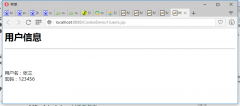首先,对话服务器将获得Mnemosyne对象的一个实例,该实例被绑定到对话服务器的本地IP上。
protected void bindMnemosyne()
{
file://得到Mnemosyne
Mnemosyne Mnemosyne = null;
try
{
Mnemosyne = MnemosyneFactory.getMnemosyne();
}
catch(RemoteException remoteException)
{
System.out.println("Internal error:");
System.out.println("Can't create a Mnemosyne");
System.exit(1);
}
// 把Mnemosyne绑定到MnemosyneImpl
try
{
String rmiURL = "//" + _localIP + "/MnemosyneImpl";
Naming.rebind(rmiURL, Mnemosyne);
}
catch(ArrayIndexOutOfBoundsException ArrayIndexOutOfBoundsException)
{
throw new IllegalArgumentException("LocalIP is invalid");
}
catch(MalformedURLException malformedURLException)
{
throw new IllegalArgumentException("LocalIP is invalid");
}
catch(RemoteException remoteException)
{
System.out.println("Internal error:");
System.out.println("Can't rebind a Mnemosyne to MnemosyneImpl");
System.exit(1);
}
}
通过把本地Mnemosyne上一系列代表RMI名字符号的URL赋予远程对话服务器,就能引发同步操作,这些URL存贮在一个被称作rmiURL的字符串数组中。在SessionServer的符号中,URL是作为参数从命令行命令中获得的,但它可以来自其他渠道:
protected void synchronizeMnemosyne()
{
file://获得本地Mnemosyne
Mnemosyne localMnemosyne = null;
try
{
localMnemosyne = (Mnemosyne) Naming.lookup(_localIP);
}
catch(Exception exception)
{
System.out.println("Internal error:");
System.out.println("Can't lookup local MnemosyneImpl");
System.exit(1);
}
file://获得同步用的远程Mnemosynes
Vector remoteMnemosynes = new Vector();
// _rmiURLS对象是代表需要进行同步的远程服务器的字符串数组
for(int index = 1;index < _rmiURLS.length;index++)
{
try
{
remoteMnemosynes.add(Naming.lookup(_rmiURLS[index]));
}
catch(Exception exception)
{
}
}
file:// 同步
try
{
if(remoteMnemosynes.size() > 1)
localMnemosyne.synchronize(remoteMnemosynes);
}
catch(Exception exception)
{
System.out.println("Internal error:");
System.out.println("Can't synchronize local MnemosyneImpl");
System.exit(1);
}
}
protected void bindMnemosyne()
{
file://得到Mnemosyne
Mnemosyne Mnemosyne = null;
try
{
Mnemosyne = MnemosyneFactory.getMnemosyne();
}
catch(RemoteException remoteException)
{
System.out.println("Internal error:");
System.out.println("Can't create a Mnemosyne");
System.exit(1);
}
// 把Mnemosyne绑定到MnemosyneImpl
try
{
String rmiURL = "//" + _localIP + "/MnemosyneImpl";
Naming.rebind(rmiURL, Mnemosyne);
}
catch(ArrayIndexOutOfBoundsException ArrayIndexOutOfBoundsException)
{
throw new IllegalArgumentException("LocalIP is invalid");
}
catch(MalformedURLException malformedURLException)
{
throw new IllegalArgumentException("LocalIP is invalid");
}
catch(RemoteException remoteException)
{
System.out.println("Internal error:");
System.out.println("Can't rebind a Mnemosyne to MnemosyneImpl");
System.exit(1);
}
}
通过把本地Mnemosyne上一系列代表RMI名字符号的URL赋予远程对话服务器,就能引发同步操作,这些URL存贮在一个被称作rmiURL的字符串数组中。在SessionServer的符号中,URL是作为参数从命令行命令中获得的,但它可以来自其他渠道:
protected void synchronizeMnemosyne()
{
file://获得本地Mnemosyne
Mnemosyne localMnemosyne = null;
try
{
localMnemosyne = (Mnemosyne) Naming.lookup(_localIP);
}
catch(Exception exception)
{
System.out.println("Internal error:");
System.out.println("Can't lookup local MnemosyneImpl");
System.exit(1);
}
file://获得同步用的远程Mnemosynes
Vector remoteMnemosynes = new Vector();
// _rmiURLS对象是代表需要进行同步的远程服务器的字符串数组
for(int index = 1;index < _rmiURLS.length;index++)
{
try
{
remoteMnemosynes.add(Naming.lookup(_rmiURLS[index]));
}
catch(Exception exception)
{
}
}
file:// 同步
try
{
if(remoteMnemosynes.size() > 1)
localMnemosyne.synchronize(remoteMnemosynes);
}
catch(Exception exception)
{
System.out.println("Internal error:");
System.out.println("Can't synchronize local MnemosyneImpl");
System.exit(1);
}
}







